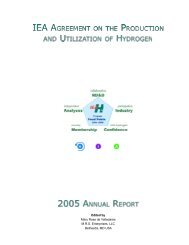Technology Status of Hydrogen Road Vehicles
Technology Status of Hydrogen Road Vehicles
Technology Status of Hydrogen Road Vehicles
Create successful ePaper yourself
Turn your PDF publications into a flip-book with our unique Google optimized e-Paper software.
To ease the introduction <strong>of</strong> a new technology, examining some <strong>of</strong> the worst-case accidents may be advisable,<br />
and would help overcome a subjective public assessment.<br />
The worst case for LH 2/LNG tanks is a burst releasing all mechanical, chemical, and thermal energy stored.<br />
An experimental series <strong>of</strong> tests was divided in two parts to test the consequences:<br />
1. LH 2 was abruptly released at 2.5 times the operating pressure using a cutting charge. This gave<br />
information on the fundamental processes involved when LH 2 tanks burst, an obvious conclusion being<br />
that the operating pressure should be kept as low as possible.<br />
2. A fault tree analysis identified the potential real mechanisms for burst (pressure buildup, fire, mechanical<br />
damage), and the consequences were measured.<br />
The pressure buildup tests, such as could happen in a severe road accident, were simulated by destroying the<br />
vacuum insulation and blocking the overflow/safety valves. The buildup gives an initial crack which at critical<br />
length or growth rate can give catastrophic rupture, or which can give leak-before-break. With the minimum<br />
regulatory wall thickness (2 mm) the pressure reached bursting value in 10 min, which was 15 times the<br />
maximum permissible one. The effects <strong>of</strong> these tests have been already described in Pehr (1994, 1995). With<br />
a 50% thinner wall, the initial crack allowed leak-before-break, effectively avoiding rupture.<br />
The fire tests were made with ignited propane giving >900ºC temperatures over and near the tank surface; the<br />
heat flow inward, heating and evaporating the hydrogen, was as high as 27 kW. The test rig meets the IAEA<br />
requirements for fire tests.<br />
Two tanks were subjected to the fire tests: one with inner and outer vessels <strong>of</strong> austenitic stainless steel, the<br />
other with outer vessel <strong>of</strong> the same steel but the inner vessel <strong>of</strong> cold-tough aluminum alloy. The safety valves<br />
were placed outside the fire zone to prevent premature leak, but the unburned hydrogen was













